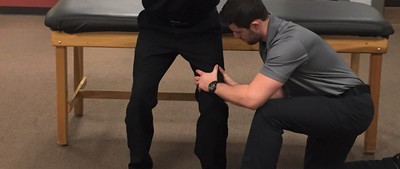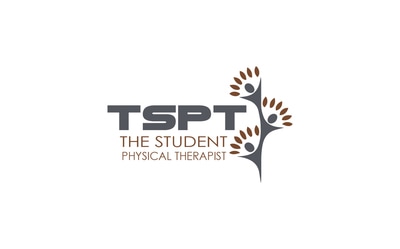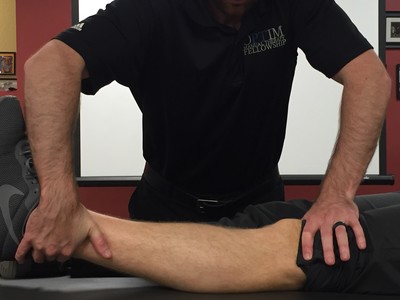- Home
- About Us
- TSPT Academy
- Online Courses
-
Resources
- Newsletter
- Business Minded Sports Physio Podcast
- Day in the Life of a Sports PT
- Residency Corner
-
Special Tests
>
-
Cervical Spine
>
- Alar Ligament Test
- Bakody's Sign
- Cervical Distraction Test
- Cervical Rotation Lateral Flexion Test
- Craniocervical Flexion Test (CCFT)
- Deep Neck Flexor Endurance Test
- Posterior-Anterior Segmental Mobility
- Segmental Mobility
- Sharp-Purser Test
- Spurling's Maneuver
- Transverse Ligament Test
- ULNT - Median
- ULNT - Radial
- ULNT - Ulnar
- Vertebral Artery Test
- Thoracic Spine >
-
Lumbar Spine/Sacroiliac Joint
>
- Active Sit-Up Test
- Alternate Gillet Test
- Crossed Straight Leg Raise Test
- Extensor Endurance Test
- FABER Test
- Fortin's Sign
- Gaenslen Test
- Gillet Test
- Gower's Sign
- Lumbar Quadrant Test
- POSH Test
- Posteroanterior Mobility
- Prone Knee Bend Test
- Prone Instability Test
- Resisted Abduction Test
- Sacral Clearing Test
- Seated Forward Flexion Test
- SIJ Compression/Distraction Test
- Slump Test
- Sphinx Test
- Spine Rotators & Multifidus Test
- Squish Test
- Standing Forward Flexion Test
- Straight Leg Raise Test
- Supine to Long Sit Test
-
Shoulder
>
- Active Compression Test
- Anterior Apprehension
- Biceps Load Test II
- Drop Arm Sign
- External Rotation Lag Sign
- Hawkins-Kennedy Impingement Sign
- Horizontal Adduction Test
- Internal Rotation Lag Sign
- Jobe Test
- Ludington's Test
- Neer Test
- Painful Arc Sign
- Pronated Load Test
- Resisted Supination External Rotation Test
- Speed's Test
- Posterior Apprehension
- Sulcus Sign
- Thoracic Outlet Tests >
- Yergason's Test
- Elbow >
- Wrist/Hand >
- Hip >
- Knee >
- Foot/Ankle >
-
Cervical Spine
>
- I want Financial Freedom
- I want Professional Growth
- I want Clinical Mastery
Pivot-Shift Test
Purpose: To assess the integrity of the MCL and ACL (rotary instability).
Test Position: Supine.
Performing the Test: The examiner should lift the tested leg off the table with the knee fully extended. Place the heel of one hand behind the fibular head of the patient. Use the other hand to grasp the tibia, while palpating the medial joint line. While maintaining a valgus force and internal rotation of the tibia throughout the test, slowly flex the patient's knee (note: the test starts by putting the tibia in the abnormal position!). A positive test occurs when the lateral tibial plateau begins anteriorly subluxed and returns to neutral as you flex the knee to around 30 degrees ("Users' Guide to the Musculoskeletal Examination: Fundamentals for the Evidence-Based Clinician").
Diagnostic Accuracy: ACUTE: Sensitivity: .32; Specificity: 1.0; +LR: 1.3; -LR: 1.0; CHRONIC: Sensitivity: .40; Specificity: .97; +LR: 7.7; -LR: .8 ("Clinical diagnosis of an anterior cruciate ligament rupture: a meta-analysis").
Importance of Test: This test is used mainly to assess anterolateral stability to the knee by recreating the knee buckling feeling. It requires an intact MCL (which is why it also tests the MCL) in order to transfer the valgus forces into a compression force on the lateral compartment. As the knee is flexed to about 30 degrees, the Iliotibial Band changes from an extensor moment arm to a flexor moment arm and shifts the subluxed tibia back into normal position. It should be noted that individuals who have been ACL deficient for awhile may have learned to protect against the "knee giving out" sensation the test reproduces by contracting opposing muscles. ("Clinical diagnosis of an anterior cruciate ligament rupture: a meta-analysis"). Often with ACL injuries, other tissues and structures can be injured as well. One of the more significant findings recently has been bone contusions with ACL injuries. Look for research on the topic coming out soon!
Note: these tests should only be used by properly trained health care practitioners
Test Position: Supine.
Performing the Test: The examiner should lift the tested leg off the table with the knee fully extended. Place the heel of one hand behind the fibular head of the patient. Use the other hand to grasp the tibia, while palpating the medial joint line. While maintaining a valgus force and internal rotation of the tibia throughout the test, slowly flex the patient's knee (note: the test starts by putting the tibia in the abnormal position!). A positive test occurs when the lateral tibial plateau begins anteriorly subluxed and returns to neutral as you flex the knee to around 30 degrees ("Users' Guide to the Musculoskeletal Examination: Fundamentals for the Evidence-Based Clinician").
Diagnostic Accuracy: ACUTE: Sensitivity: .32; Specificity: 1.0; +LR: 1.3; -LR: 1.0; CHRONIC: Sensitivity: .40; Specificity: .97; +LR: 7.7; -LR: .8 ("Clinical diagnosis of an anterior cruciate ligament rupture: a meta-analysis").
Importance of Test: This test is used mainly to assess anterolateral stability to the knee by recreating the knee buckling feeling. It requires an intact MCL (which is why it also tests the MCL) in order to transfer the valgus forces into a compression force on the lateral compartment. As the knee is flexed to about 30 degrees, the Iliotibial Band changes from an extensor moment arm to a flexor moment arm and shifts the subluxed tibia back into normal position. It should be noted that individuals who have been ACL deficient for awhile may have learned to protect against the "knee giving out" sensation the test reproduces by contracting opposing muscles. ("Clinical diagnosis of an anterior cruciate ligament rupture: a meta-analysis"). Often with ACL injuries, other tissues and structures can be injured as well. One of the more significant findings recently has been bone contusions with ACL injuries. Look for research on the topic coming out soon!
Note: these tests should only be used by properly trained health care practitioners
References:
Benjaminse A, Gokeler A, van der Schans CP. "Clinical diagnosis of an anterior cruciate ligament rupture: a meta-analysis. The Journal of orthopaedic and sports physical therapy. May 2006; 36(5):267-288. Web. 09/04/2012.
Cleland JA, Flynn TW, Whitman JM. "User's Guide to the Musculoskeletal Examination Fundamentals for the Evidence-Based Clinician: Evidence in Motion"; 2008; 264.
Benjaminse A, Gokeler A, van der Schans CP. "Clinical diagnosis of an anterior cruciate ligament rupture: a meta-analysis. The Journal of orthopaedic and sports physical therapy. May 2006; 36(5):267-288. Web. 09/04/2012.
Cleland JA, Flynn TW, Whitman JM. "User's Guide to the Musculoskeletal Examination Fundamentals for the Evidence-Based Clinician: Evidence in Motion"; 2008; 264.
Copyright © The Student Physical Therapist LLC 2023



